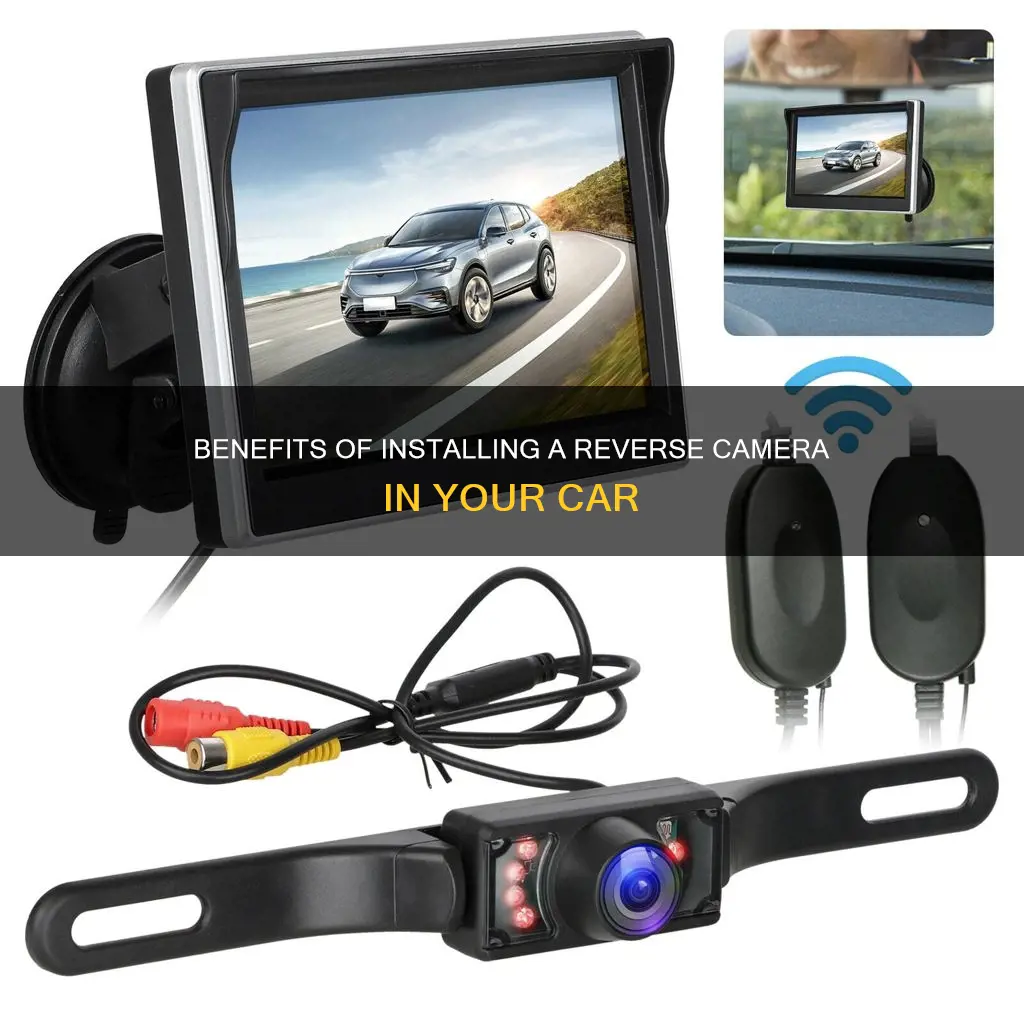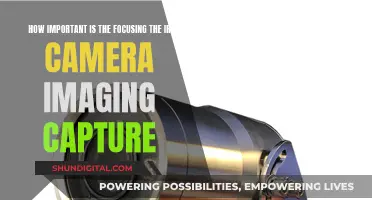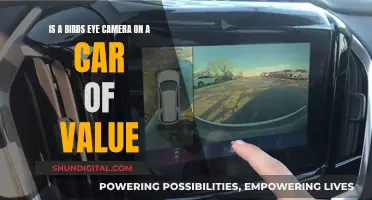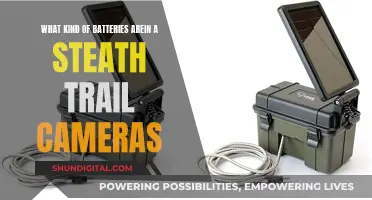
A reverse camera, also known as a backup, rear-view, or reversing camera, is a video camera attached to the rear of a vehicle to aid in reversing and reduce the rear blind spot. It provides a live feed of the area behind the car, enhancing safety, eliminating blind spots, and making parking easier. Reverse cameras are usually connected to the vehicle's head unit display and may include features such as parking guidelines and night vision. They are now legally required on all new vehicles sold in the United States and Canada.
| Characteristics | Values |
|---|---|
| Name | Reversing camera, rear-view camera, back-up camera |
| Purpose | Aid reversing, reduce rear blind spot |
| Location | Attached to the rear of a vehicle |
| Type of camera | Wide-angle, fish-eye lens |
| Camera angle | Downward-facing |
| Display | Dashboard screen, rearview mirror, windscreen, factory screen, dash monitor |
| Display activation | When the transmission is set to reverse |
| Display deactivation | When the transmission is not set to reverse |
| Guidelines | Static, dynamic, steering-linked |
| Camera mounting location | Number plate, boot handle, reversing light, pedestal |
| Camera power source | Wired, wireless, solar |
| Camera resolution | High-resolution |
What You'll Learn

How does a reverse camera work?
A reversing camera, also known as a backup, rear-view, or rear camera, is a video camera attached to the rear of a vehicle to aid in reversing and reduce the rear blind spot. The rear blind spot has been described as a "killing zone" due to the accidents it contributes to.
Reversing cameras capture live video footage of the area behind a vehicle when it is in reverse and display it on a screen in the vehicle. The image produced is a mirror image, meaning it is horizontally flipped, so that the driver's perception of left and right is correct. This is necessary because the camera and the driver face opposite directions. The image may also include static or dynamic parking lines to help the driver gauge the vehicle's distance from obstacles. These lines can be connected to the vehicle's steering and adjust based on the steering wheel's position.
The camera is typically mounted high on the tailgate or rear bumper of a vehicle, or it can be installed behind the number plate, replacing the boot handle or reversing light, or on a pedestal above the number plate. The camera is connected to a display screen, which is usually the vehicle's head unit display, such as the dashboard or rearview mirror. The display is wired to automatically activate when the transmission is set to reverse, and it remains off when the vehicle is driving forwards.
Reversing cameras are usually installed by connecting them to the vehicle's fuse box and reverse light. The camera is mounted on the rear of the vehicle, and the wires are hidden inside the vehicle's bodywork and panels.
Pigeons: Government Surveillance Cameras or Urban Legends?
You may want to see also

Benefits of a reverse camera
A reverse camera is a small, wide-angle camera mounted to the rear of a car, usually above the license plate. When the driver engages the reverse gear, the camera activates, providing a live video feed of the area behind the car. This feed is displayed on a monitor, allowing the driver to manoeuvre safely.
Enhanced Safety
Reverse cameras significantly improve safety by providing a clear view of the area behind the car. This helps drivers avoid collisions with obstacles, pedestrians, and other vehicles, especially when backing up or parking. It also reduces the risk of injury or death and prevents damage to your car and those around you.
Eliminate Blind Spots
The rear-view mirror has limitations and doesn't always provide a complete view of the car's surroundings. Reverse cameras help eliminate blind spots, especially at the rear bottom of the car, by providing a clear and undistorted view. This is particularly useful when driving near parks, schools, or other public places, ensuring the safety of children and pets.
Improved Maneuverability
Reverse cameras make parking and reversing more precise and convenient, especially in tight spaces or congested areas. The camera provides a bottom view of the area behind the car, making it easier to judge distances and manoeuvre without assistance. This feature is also helpful when hooking up trailers, as it provides guidelines to gauge distance and avoid obstacles.
Accident Prevention
The real-time video feed from reverse cameras helps prevent accidents by providing an early view of obstacles. This is especially crucial in busy traffic or when backing up, as it reduces the chances of colliding with another vehicle or object. Some cameras also have warning tones or sensors that alert drivers when they are too close to an object.
Peace of Mind
Having a reverse camera provides drivers with peace of mind and confidence while reversing. Knowing that the area behind the car is being monitored reduces stress and anxiety, especially for inexperienced drivers or when driving in challenging conditions.
Overall, reverse cameras offer a range of benefits that improve safety, convenience, and driving experience. They are now standard in new car models, and even older cars can be retrofitted with this technology to enjoy its advantages.
The Keystone K7 Camera: A Rare Vintage Find
You may want to see also

Different types of reverse cameras
Reverse cameras, also known as backup or rear-view cameras, are designed to aid in reversing and reducing the rear blind spot. They are typically mounted on the rear of a vehicle and connected to the dashboard screen or rearview mirror. There are several types of reverse cameras available, each offering unique features and benefits.
One type is the aftermarket addition, which can be added to vehicles that lack factory-fitted systems. These come in both wired and wireless versions, with the latter being easier and cheaper to install. Wireless backup cameras, for example, do not require cables between the camera and display, relying on remote activation when the reverse gear is engaged.
For large vehicles like motorhomes, camera systems with built-in servomechanisms are available. These allow the driver to remotely pan and tilt the camera for a better field of view. On the other hand, portable or semi-permanent all-in-one camera systems, also known as dashboard or dash cameras, are designed for vehicles without permanent dashboard displays.
Night vision cameras are another variety, employing infrared lights for enhanced visibility in low-light conditions. These are particularly useful when reversing in the dark, providing a clearer view than traditional white reverse lights.
Some reverse cameras are integrated into the rearview mirror, offering a discreet solution without cluttering the dashboard. Additionally, there are license-plate-frame versions that allow for installation without permanent vehicle modifications.
Custom cameras, such as brake light cameras, combine a camera with brake light functionality. Certain backup cameras also use LEDs surrounding the lens to illuminate the surroundings, enhancing visibility further.
When choosing a reverse camera, consider factors such as installation ease, vehicle type compatibility, viewing angle, price, and durability. Wired cameras offer stable connections, while wireless options provide simpler installation but may face signal interference issues.
Exploring VR Mode in Cameras: An Immersive Experience
You may want to see also

Where is the reverse camera mounted?
The reverse camera is mounted on the rear of the vehicle, and there are a few options for installation.
One option is to mount the camera behind the number plate. This can be done by attaching a small camera to the front of the license plate, or by mounting it behind the plate, with the screws that hold the plate in place also securing the camera. The wires can be hidden by the number plate, leaving only the small camera visible.
Another option is to replace the existing boot handle or reversing light with a camera. This option is barely visible, giving a factory-fitted look.
A third option is a pedestal camera that sits just above the number plate. This will always be on show, but it is a good choice if you don't want to replace any existing features.
For vehicles like boats and caravans, there are also camera kits that extend the vehicle's reverse camera, allowing you to see directly behind you.
Surveillance Cameras: Buying Guide for Beginners
You may want to see also

How is a reverse camera installed?
Installing a reverse camera in your car is a great way to improve safety, eliminate rear blind spots, and make parking easier. Here's a step-by-step guide on how to install a reverse camera:
Step 1: Purchase the Necessary Equipment
Before you begin, make sure you have all the required equipment. This includes a mountable backup camera designed for your specific vehicle, an external or internal monitor, and power and video cords if they didn't come with your camera and monitor.
Step 2: Remove the License Plate and Interior Trunk Panel
Using a Phillips head screwdriver, remove the screws holding your rear license plate in place and set it aside. Then, open your trunk and remove the interior trunk panel to expose the rear wiring chambers.
Step 3: Drill a Hole and Run the Camera Cable
Drill a small hole in the license plate mounting area, ensuring there are no obstructions. Place a rubber grommet around your camera cable to keep it in place and prevent leaks, and then pull the cable through the drilled hole into the trunk.
Step 4: Locate and Strip the Reverse Light Wires
Find the reverse light wires, which connect the tail lights to the dashboard. Using a wire stripper or pliers, remove the rubber covering the wires and separate the individual wire strands.
Step 5: Fuse the Camera Wires with the Reverse Light Wires
Attach a bare wire cable to the camera's power connector and poke it through the exposed reverse light wires, twisting them together. Ensure you match the positive and negative wires correctly. Wrap the combined wires with electrical tape for safety.
Step 6: Route the Camera's Video Cable to the Front of the Car
Connect the RCA cable to the camera's video connector and run it through the vehicle towards the fuse box. This may involve removing panels and routing the cable through exposed chambers.
Step 7: Mount the Monitor
If you're using an external monitor, attach the mount to the windshield according to the manufacturer's instructions, and then hook the monitor onto the mount. For an internal monitor, clip it onto your current rearview mirror or replace the mirror entirely, depending on the design.
Step 8: Connect the Monitor's Splitter Cable to the Fuse Box
Route the monitor's power and video cable to the area next to the fuse box. Connect the video cable to the camera's RCA cord and wrap the connected cords with electrical tape. Attach the power cable to a fuse tap and crimp the cables together with pliers.
Step 9: Mount the Camera
Return to the back of the car and connect the backup camera to its power and video cable. Mount the camera to your license plate, following the manufacturer's instructions.
Step 10: Reattach the License Plate and Trim Panels
Use a Phillips head screwdriver to reattach the rear license plate and give it a firm tug to ensure it's secure. Reattach any interior trunk panels and other trim panels that were removed.
Step 11: Test the Camera
Before using your new reverse camera on public roads, test it in a safe area to ensure it's functioning properly. If there are any issues, refer to the installation manual for troubleshooting information.
History of Brownie Hawkeye Camera: When Was It Made?
You may want to see also
Frequently asked questions
A reverse camera, also known as a backup, rear-view, or reversing camera, is a video camera attached to the rear of a vehicle to aid in reversing and reduce the rear blind spot.
The camera is typically connected to the vehicle's head unit display or dashboard monitor. It automatically activates when the transmission is set to reverse, providing a live feed of the area behind the vehicle.
Reverse cameras improve safety by enhancing visibility, eliminating blind spots, and reducing the risk of collisions. They make parking easier, help prevent damage to the vehicle, and provide peace of mind while driving.
The camera is mounted on the rear of the vehicle, often behind the number plate, on the boot handle, or as a pedestal above the number plate. The camera and monitor are powered by a connection to the car's fuse box and reverse light, with wires hidden inside the bodywork.
Yes, reverse cameras can be wired or wireless, and they offer various features such as night vision, surround-view systems, and built-in audio intercoms. Some cameras also include parking guidelines that adjust based on steering and wheel movements.







